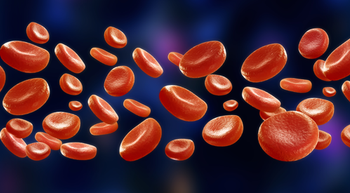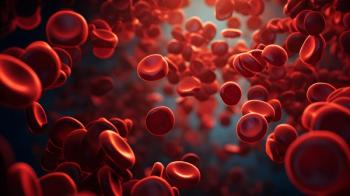
Niraparib/Abiraterone Combo Linked to Improved rPFS in Select Patients With mCRPC
Frontline niraparib, abiraterone acetate, and prednisone yielded improved radiographic progression-free survival in patients with metastatic castration-resistant prostate cancer.
Patients with metastatic castration-resistant prostate cancer (mCRPC) and homologous recombination repair (HRR) gene alterations who received frontline treatment with niraparib (Zejula), abiraterone acetate (Zytiga), and prednisone experienced superior radiographic progression-free survival (rPFS) in comparison with those who received placebo plus abiraterone/prednisone, according to findings from the phase 3 MAGNITUDE trial (NCT03748641) that were presented during the 2022 Genitourinary Cancers Symposium.1
At a median follow-up of 18.6 months, the results showed that niraparib plus abiraterone led to a 47% reduction in the risk of progression or death in patients with BRCA1/2 mutations and a 27% reduction in the risk of progression or death in all patients with HRR gene alterations vs placebo plus abiraterone.
In the BRCA1/2 population, the median rPFS was 16.6 months with niraparib plus abiraterone vs 10.9 months with placebo plus abiraterone (HR, 0.53; 95% CI, 0.36-0.79; P = .0014). The investigator-assessed rPFS was 19.3 months with niraparib/abiraterone and 12.4 months with placebo/abiraterone (HR, 0.50; 95% CI, 0.33-0.75; P = .0006).
Among all patients with HRR gene alterations, the median rPFS was 16.5 months vs 13.7 months, respectively (HR, 0.73; 95% CI, 0.56-0.96; P = .0217). Here, the investigator-assessed rPFS was 19.0 months and 13,9 months, respectively (HR, 0.64; 95% CI, 0.49-0.86; nominal P = .0022).
“The MAGNITUDE study results support niraparib plus abiraterone as a new first-line treatment option for patients with mCRPC and alterations in genes associated with HRR,” lead study author Kim N. Chi, MD, senior research scientist, Vancouver Prostate Centre, chief medical officer and vice president, BC Cancer, medical oncologist, BC Cancer–Vancouver, and professor, Department of Medicine, The University of British Columbia in Vancouver, BC, Canada, said in a presentation of the data.
As many as 30% of patients with mCRPC will harbor alterations in genes associated with HRR. Although these alterations reflect poor prognosis, they have also shown increased sensitivity to PARP inhibitors such as niraparib, Chi explained. Notably, the addition of an antiandrogen agent like abiraterone has been theorized to augment responses in all-comers, serving as the rationale for the randomized, double-blind MAGNITUDE trial, which evaluated the value of adding niraparib to abiraterone in patients with mCRPC with and without HRR gene alterations.
The study enrolled patients with mCRPC who had received no more than 4 months of prior abiraterone and prednisone for mCRPC; had an ECOG performance status of 0 or 1; and had a Brief Pain Inventory-Short Form worst pain score of 3 or less. Eligible patients were screened for HRR alterations in ATM, BRCA1, BRCA2, BRIP1, CDK12, CHEK2, FANCA, HDAC2, and PALB2.
Based on prescreening results, patients were allocated into the biomarker-positive cohort or the biomarker-negative cohort, which had a planned enrollment of 400 and 600 patients, respectively.
Patients were randomized 1:1 to receive 200 mg of niraparib once daily plus abiraterone or placebo plus abiraterone in each of the cohorts.
The primary end point was rPFS assessed by blinded independent central review in the BRCA1/2 population followed by all other biomarker populations. Secondary end points were the time to initiation of cytotoxic chemotherapy, time to symptomatic progression, and overall survival (OS). Other end points included time to prostate-specific antigen (PSA) progression, objective response rate (ORR), time to second disease progression (PFS2), time to pain progression, and patient-reported outcomes.
Patients were stratified by whether they had received prior taxane-based chemotherapy for metastatic castration-sensitive disease; prior androgen receptor inhibition for nonmetastatic castration-resistant disease or metastatic castration-sensitive disease; prior abiraterone plus prednisone for frontline mCRPC treatment; and BRCA1/2 vs other HRR gene alterations.
The statistical analysis included a prespecified futility analysis in the biomarker-negative population after approximately 200 patients were enrolled and approximately 125 compositive events of either radiographic or PSA progression or death had occurred.
Findings from the preplanned futility analysis in 233 biomarker-negative patients failed to show the benefit of adding niraparib to abiraterone in the prespecified composite end point of radiographic or PSA progression (HR, 1.09; 95% CI, 0.75-1.59). With added grade 3/4 toxicity in the niraparib arm, the Independent Data Monitoring Committee recommended halting enrollment to this cohort.
As such, only a total of 423 patients with HRR gene alterations were subsequently randomized to niraparib plus abiraterone (n = 212) or placebo plus abiraterone (n = 211).
Regarding baseline characteristics, the median age was 69 years (range, 43-100). In the niraparib and placebo arms, respectively, 23.6% (n = 50) and 22.7% (n = 48) of patients had prior abiraterone/prednisone, 24.1% (n = 51) and 18.5% (n = 39) had visceral metastases, and 46.3% (n = 98) and 43.6% (n = 92) had BRCA1/2 mutations.
Additional findings showed that rPFS favored niraparib across all prespecified biomarker positive subgroups.
Notably, the addition of niraparib to abiraterone prolonged time to initiation of cytotoxic chemotherapy (HR, 0.59; 95% CI, 0.39-0.89; P = .0108), time to symptomatic progression (HR, 0.69; 95% CI, 0.47-0.99; P = .0444), and time to PSA progression (HR, 0.57; 95% CI, 0.43-0.76; P = .0001) in all patients with HRR gene alterations. Moreover, the ORR was improved with niraparib vs placebo, at 60% (n = 55/92) vs 28% (n = 23/82; relative risk, 2.13; P < .001).
Similarly, niraparib delayed the time to initiation of cytotoxic chemotherapy (HR, 0.58; 95% CI, 0.33-1.01; P = .0495), time to symptomatic progression (HR, 0.68; 95% CI, 0.42-1.11; P = .1224), and time to PSA progression (HR, 0.46; 95% CI, 0.30-0.69; P = .0002) in all patients with BRCA1/2 mutations. Additionally, the ORR was improved with niraparib vs placebo, at 52% (n = 29/56) vs 31% (n = 15/48; relative risk, 1.66; P = .035).
Although data from the first interim analysis of OS were immature (HR, 0.94; 95% CI, 0.65-1.36; P = .733), a multivariate analysis accounting for baseline characteristics showed favorable outcomes with niraparib (HR, 0.767; 95% CI, 0.525-1.119; P = .1682).
In terms of safety, no new signals were seen. All-grade treatment-emergent adverse effects (AEs) occurred in 99.1% (n = 210) of patients in the niraparib arm vs 94.3% (n = 199) of patients in the placebo arm. The most common all-grade AEs in the niraparib arm were anemia (46.2%; n = 98), hypertension (31.6%; n = 67), and constipation (30.7%; n = 65). The most common AEs in the placebo arm were hypertension (22.3%; n = 47), anemia (20.4%; n = 43), and fatigue (16.6%; n = 35).
Sixty-seven percent (n = 142) of patients in the niraparib arm experienced grade 3/4 AEs vs 46.4% (n = 98) of patients in the placebo arm. The most common grade 3/4 AEs in the niraparib arm were anemia (29.7%; n = 63), hypertension (15.6%; n = 33), and thrombocytopenia and neutropenia (each, 6.6%; n = 14) vs hypertension (14.2%; n = 30), anemia (7.6%; n = 16), and hepatotoxicity (4.7%; n = 10) in the placebo arm.
Dose reductions occurred in 19.8% (n = 42) of patients on niraparib with a median relative dose intensity of 99%. The most common AEs leading to dose reduction in the niraparib arm were anemia (13.2%) and thrombocytopenia (2.8%).
Additionally, 10.8% (n = 23) and 4.7% (n = 10) of patients discontinued treatment in the niraparib and placebo arms due to AEs, respectively. Deaths due to an AE occurred in 11 (5.2%) of patients on niraparib vs 7 (3.3%) of those on placebo.
Notably, no clinically significant differences in overall quality of life were seen between the study arms, according to results from The Functional Assessment of Cancer Therapy-Prostate questionnaire.
“MAGNITUDE highlights the importance of testing for HRR gene alterations in patients with mCRPC, to identify who will optimally benefit from the combination of niraparib plus abiraterone,” Chi concluded.
Reference
1. Chi KN, Rathkopf DE, Smith MR, et al. Phase 3 MAGNITUDE study: first results of niraparib (NIRA) with abiraterone acetate and prednisone (AAP) as first-line therapy in patients (pts) with metastatic castration-resistant prostate cancer (mCRPC) with and without homologous recombination repair (HRR) gene alterations. J Clin Oncol. 2022;40(suppl 6):12. doi:10.1200/JCO.2022.40.
Newsletter
Knowledge is power. Don’t miss the most recent breakthroughs in cancer care.

















































































